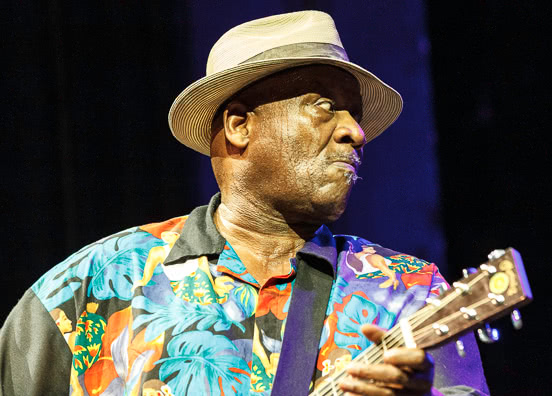Easter and blues music have been tied together in Sydney for close to a quarter of a century, and the Byron Bay Blues Festival has been responsible for much of that history.
Although Bluesfest had over 90 acts appearing this year, you would find it hard to say that more than a dozen could actually be labelled ‘blues’ artists . With that in mind, it was a rather special event to have a mini-Bluesfest at the Enmore Theatre in Sydney, which gathered three of these names on the same bill.
Shuggie Otis was a childhood prodigy on guitar back in the early ‘60s. He played with his dad, Johnny Otis, when he was 12 by donning sunglasses and a fake moustache to get into bars and clubs. Otis was schooled by playing these live shows, on many nights lerobert-craytting out a groove to his father’s magical “Willie And The Hand Jive”.
With an eight-piece band tonight, including three horn players, the music touched on funk with some blues thrown in. “Aht Uh Mi Head (Out Of My Head)” was smooth and delivered well, and “Sweetest Thing” was the highlight of his short set, where Otis let loose on some blues riffs and the horn section brought it home.
Otis had intended to play more songs, but his time ran out before he could deliver them and the band left the stage in a state of apparent confusion.
Henry Saint Clair Fredericks is better known by his stage name, Taj Mahal. Mahal’s real life stature is large and his impact on the blues scene has been just as huge over the last 50 years. His presence on a stage commands your attention and the energy level in the room noticeably rose when the Taj Mahal trio hit the stage.
While Mahal screamed and moaned and growled the blues, drummer Kester Smith and bassist Larry Fulcher kept a tight rhythm going and played with huge smiles throughout the set.
Taj Mahal has always mixed flavours of other music into his blues, from calypso to funk to African roots music. “Blues With A Feelin’”, a slow blues ballad, had Mahal on the piano, and though he was worried about the sound being “too hot” at first, he brought it under control and clearly showed his keyboard talent. While a banjo was later unsheathed for a superb version of “Doin’ Time”, Mahal mainly stuck to guitar and real blues vocalising throughout his warm and professional set.
“Blues Is Alright” was a sing-along for the entire Enmore blues crowd and everyone seemed to enjoy raising their voice, even if no one got to their feet. With Mahal’s tropical shirt, straw hat and guitar strapped on, “Annie Mae” was another a tour de force from this joyous trio.
Revisiting a very old song from his 1969 album The Natch’ll Blues, “Going Up The Country And Paint My Mailbox Blue”, had the audience screaming for more as Mahal sang with passion and fired off some super blues licks. Taj Mahal proved once again that his showmanship and music only improves with age.
Robert Cray is sometimes overlooked in the spectrum of blues because of his smooth and soulful style of singing and playing. What many forget, however, is that without his fame in 1983 and onwards, the blues might even be less popular than it is today. He may not be low down and dirty or as flashy as some other players, but Cray plays with a clarity and distinct tone that is he truly owns.
Dressed in trousers, a checked shirt and sandals, Cray looked like an unlikely blues guitar-slinger, but his style certainly fits his personal mixture of jazz, soul and blues.
“Poor Johnny” brought slow burning blues from his 2005 album Twenty, Cray soloing and jamming with his excellent backing band. Joe Pugh was outstanding on keyboards and Richard Cousins equally superb on bass. The combo was as tight as a pair of skinny jeans on a slightly overweight groover.
“Chicken In The Kitchen” was a perfect blues rave up on guitar and really allowed Cray to let loose. His lyrics are always about some woman or man doing someone wrong and this was no exception. Pugh’s organ and the precision of Cray’s picking made this track the highlight of the evening.
Slow blues numbers like “It Doesn’t Show” were well received, with one female admirer yelling out her love for Cray and the guitarist answering in an echoing falsetto that left him and the audience in fits of laughter.
The difficult part of a blues show with Cray is that aforementioned mix of styles. Just when you think the room and band are going to enter into an up-tempo jam, the mood instead changes to soulful, introspective blues. Cray getting down and dirty for an entire set is something that simply will not happen, but it would certainly be interesting to hear.
“Smoking Gun” and “Strong Persuader” are long standing numbers in the set and Cray did not let his Australian fans down. These songs are benchmarks for Cray and for those who discovered blues through him – a generation of listeners who were bombarded with these tracks 28 years ago.
Robert Cray may meander at times in his style of songs, but whichever way he goes, craftsmanship and authenticity are never lacking.

































